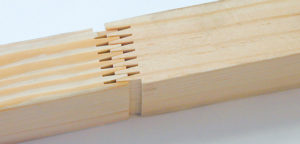Finger Jointed Timber is available in a range of sizes and grades based on customer requirements.
The Wood Processors & Manufacturers Association of New Zealand states that New Zealand pine compares favourably with other softwood species for producing finger jointed products. It machines well, producing smooth, clean cuts with a minimum of crushing or splintering at the cut surface or face. High production rates can be achieved and wear on the machine cutter knives is low. Machining quality and the uniform colour have led to its increasing acceptance for finger-jointing.
Finger-jointed products supply two main market segments. Structural wood products are produced with the joints designed to have high tensile strengths. Finger-jointing provides more stability than single, large dimension lumber pieces which can in certain circumstances be prone to distortion. The structural joints for New Zealand pine use finger lengths of 10mm through to 25mm, though shorter finger lengths of 10mm are preferred. Adhesives used in structural jointing such as phenol resorcinol and melamine urea-based glues must meet strict exterior and exposure tests. New Zealand finger-jointed pine meets the requirements of New Zealand, Australia, Japanese, USA and British structural testing standards. Extensive qualification to recognised national standards and in-house quality control tests are conducted by finger-joint manufacturers to verify the on-going strength and reliability of the timber joints.
Finger-jointed lumber is used for a wide range of products where appearance is important. For this end use the 4mm ‘micro joint’ is offered by New Zealand manufacturers for Australasian markets as it is easily jointed, it provides a high-quality finish and results in higher timber yields. When clear adhesives are used, unblemished lengths of finger jointed timber can be produced for high value end uses. Appearance grade finger jointed products include mouldings. Fascia boards, handrails, balustrades, door and window components and weatherboard.

Processing types
New Zealand pine can be jointed using either the face-to-face (vertical or European joint) or the edge-to-edge (horizontal or North American joint) machine types. The horizontal joint, where the fingers are oriented so that they can be seen on the edge or side of the board, are generally preferred in the USA for moulding and millwork operations, and the vertically milled joint for structural applications.